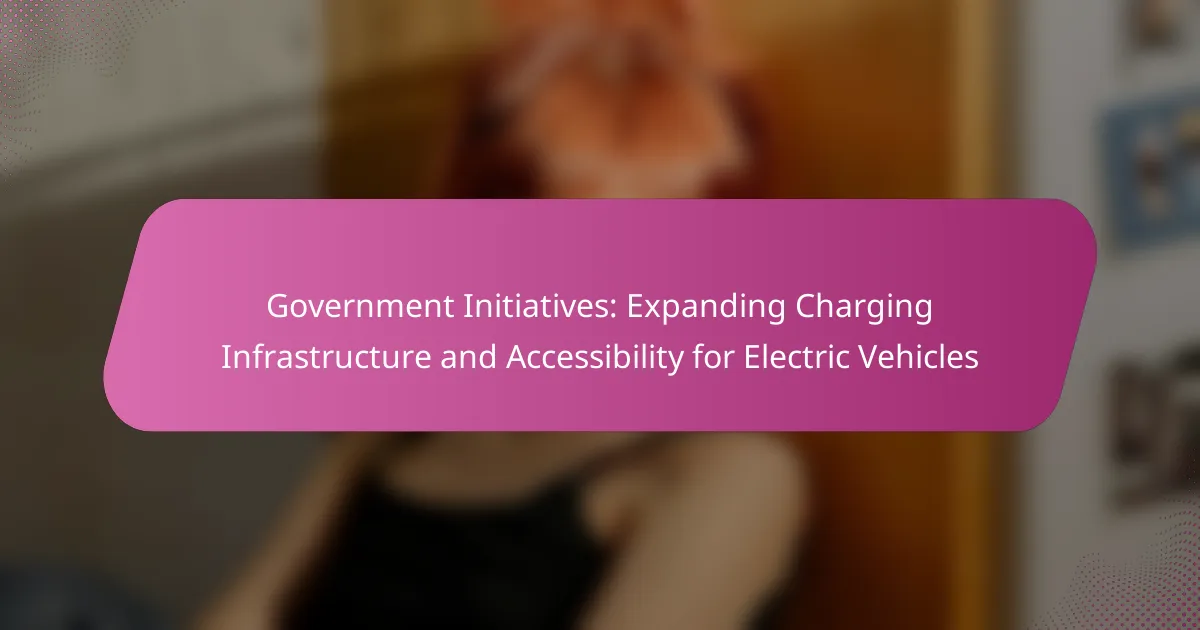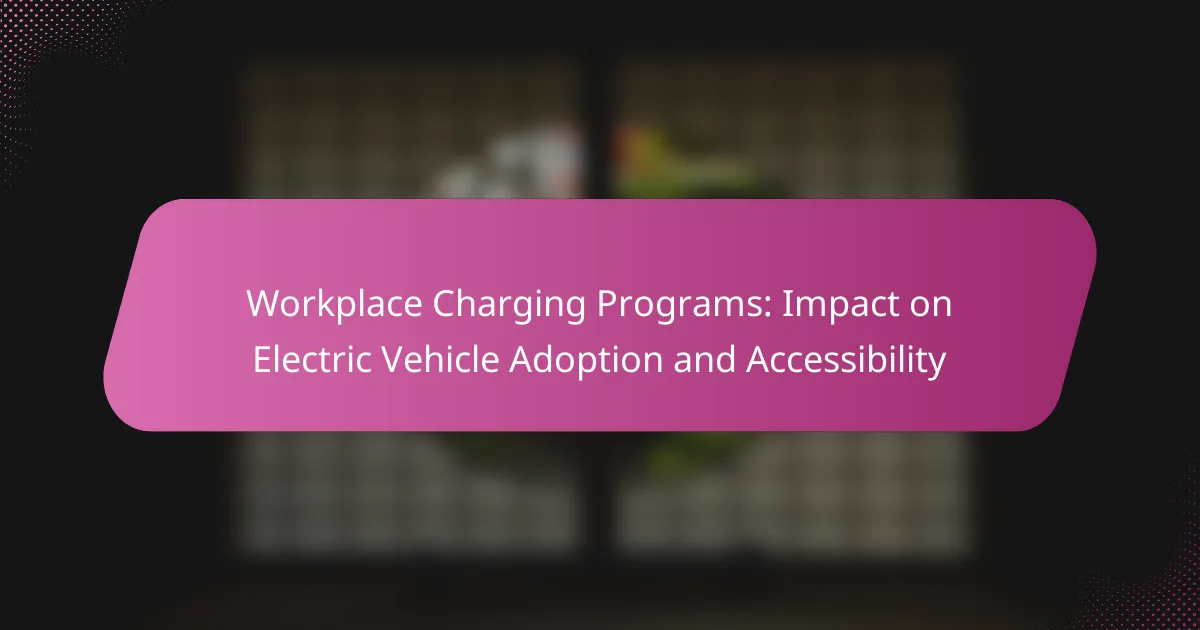Governments across the United States are actively working to expand electric vehicle (EV) charging infrastructure through funding programs and partnerships with private entities. This initiative aims to enhance the availability and accessibility of charging stations, ultimately encouraging more consumers to adopt EVs. States like California, New York, and Texas are leading the charge, implementing various strategies to ensure that both urban and rural areas benefit from this growing network.

How are governments expanding electric vehicle charging infrastructure in the US?
Governments in the US are expanding electric vehicle (EV) charging infrastructure through various funding programs, state initiatives, and partnerships with private entities. These efforts aim to increase the availability and accessibility of charging stations, making EV adoption more feasible for consumers.
Federal funding programs
The federal government has launched several funding programs to support the expansion of EV charging infrastructure. Notably, the Bipartisan Infrastructure Law allocates billions of dollars to build a nationwide network of charging stations, focusing on highways and underserved areas.
These programs often provide grants to state and local governments, as well as private companies, to develop charging stations. Applicants typically need to demonstrate how their projects will enhance accessibility and reliability for EV users.
State-level initiatives
Many states have implemented their own initiatives to complement federal efforts. For example, California has set ambitious goals to increase the number of charging stations and offers incentives for businesses and homeowners to install chargers.
States may also create regulations that require new buildings to include EV charging capabilities or mandate a certain number of charging stations in public parking areas. These measures help ensure that charging infrastructure keeps pace with the growing number of electric vehicles on the road.
Public-private partnerships
Public-private partnerships are crucial in expanding EV charging infrastructure. Collaborations between government entities and private companies can accelerate the deployment of charging stations by leveraging resources and expertise from both sectors.
These partnerships often involve shared funding models, where both parties contribute financially to the installation and maintenance of charging stations. Successful examples include collaborations with major retailers and energy companies, which can provide strategic locations for charging stations while enhancing consumer convenience.

What are the benefits of increased charging accessibility?
Increased charging accessibility for electric vehicles (EVs) offers numerous advantages, including higher adoption rates, reduced range anxiety, and a positive impact on the environment. By expanding the charging infrastructure, governments can facilitate a smoother transition to electric mobility.
Improved EV adoption rates
Enhanced charging accessibility directly contributes to improved EV adoption rates. When potential buyers see a robust network of charging stations, they are more likely to consider purchasing an electric vehicle, knowing they can conveniently charge their cars.
For example, regions with a high density of charging stations often report adoption rates that are significantly higher than areas with limited infrastructure. This trend encourages manufacturers to invest in EV technology and production, further driving down costs and expanding options for consumers.
Reduced range anxiety for drivers
Increased charging accessibility alleviates range anxiety, a common concern among potential EV owners regarding the distance they can travel on a single charge. With more charging stations available, drivers can confidently plan longer trips without worrying about running out of battery.
Charging stations located at strategic points, such as highways, shopping centers, and urban areas, offer peace of mind. Drivers can easily find a nearby station, reducing the fear of being stranded and encouraging more frequent use of electric vehicles.
Environmental impact reduction
Expanding charging infrastructure plays a crucial role in reducing the environmental impact of transportation. As more drivers switch to electric vehicles, greenhouse gas emissions from fossil fuel-powered cars decrease, contributing to cleaner air and a healthier planet.
Moreover, the integration of renewable energy sources into charging stations can further enhance these benefits. For instance, solar-powered charging stations not only provide energy for EVs but also promote sustainable energy practices, making a significant contribution to environmental conservation efforts.
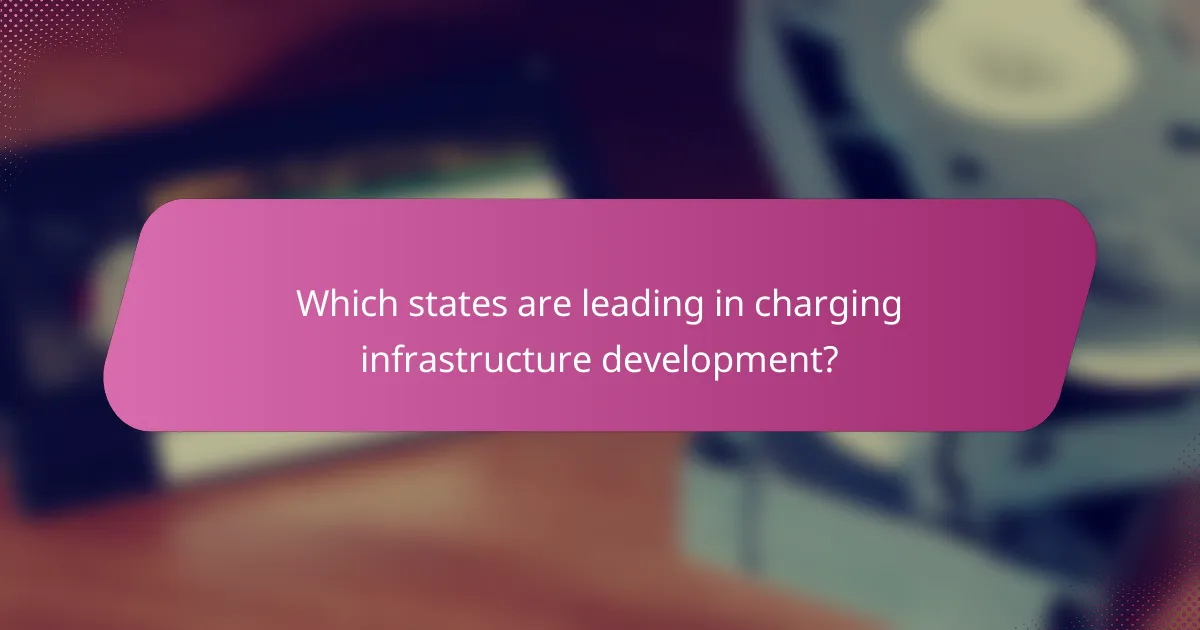
Which states are leading in charging infrastructure development?
California, New York, and Texas are at the forefront of electric vehicle (EV) charging infrastructure development in the United States. These states have implemented various initiatives to enhance accessibility and expand the network of charging stations, catering to both urban and rural areas.
California’s extensive network
California boasts one of the most extensive EV charging networks in the country, with tens of thousands of public charging stations available. The state has invested heavily in infrastructure, supported by policies that encourage the installation of charging points in both public and private spaces.
Key initiatives include the California Electric Vehicle Infrastructure Project, which aims to increase the availability of fast chargers along major highways. This extensive network not only supports local EV owners but also attracts long-distance travelers, making electric vehicle use more practical across the state.
New York’s investment in urban charging
New York is focusing on urban areas to enhance EV charging accessibility, with significant investments aimed at increasing the number of charging stations in densely populated cities. The state has launched programs to subsidize the installation of chargers in public parking facilities and along city streets.
Through initiatives like the ChargeNY program, New York aims to install thousands of charging stations by offering financial incentives to businesses and municipalities. This approach not only promotes electric vehicle adoption but also addresses the unique challenges of urban infrastructure.
Texas’s growth in rural charging stations
Texas is making strides in expanding charging infrastructure in rural areas, recognizing the need for accessible charging options beyond urban centers. The state has initiated programs to facilitate the installation of charging stations along highways and in smaller communities.
Efforts include partnerships with local governments and private companies to deploy charging stations in strategic locations. This growth is crucial for supporting the increasing number of electric vehicles in Texas, ensuring that rural residents have equal access to charging facilities as their urban counterparts.
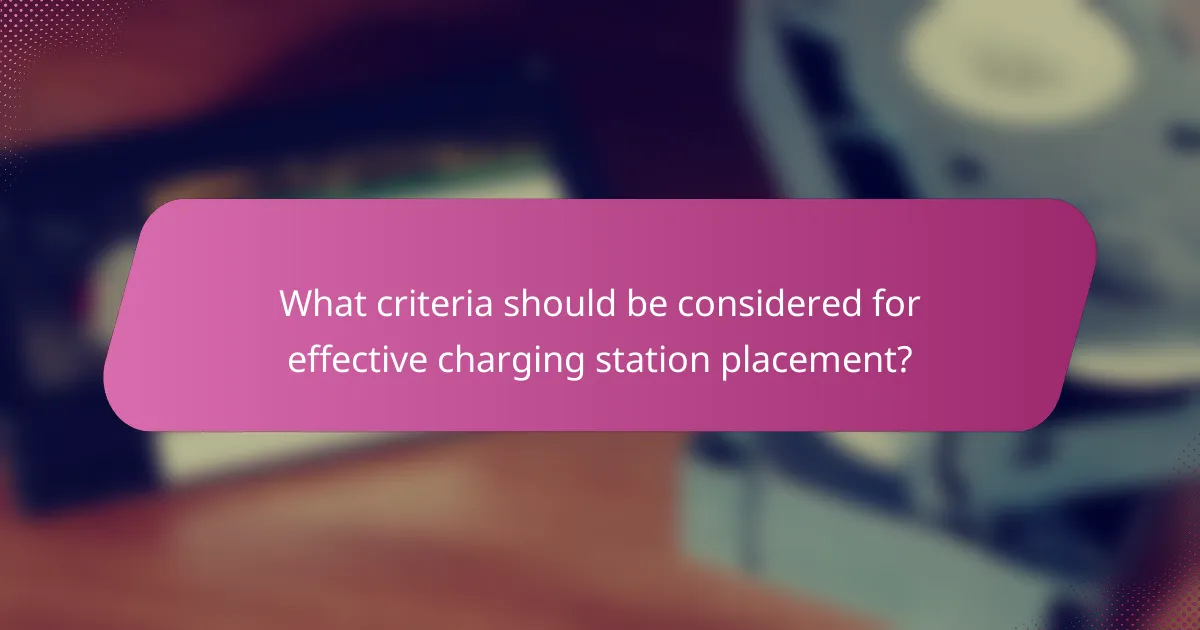
What criteria should be considered for effective charging station placement?
Effective charging station placement requires careful consideration of traffic patterns, proximity to amenities, and accessibility for disabled users. These factors ensure that charging stations meet the needs of electric vehicle (EV) users efficiently and conveniently.
Traffic patterns analysis
Analyzing traffic patterns is crucial for identifying high-demand locations for charging stations. Areas with heavy vehicle flow, such as major highways, urban centers, and popular travel routes, are ideal for placement. Monitoring data from navigation apps can help pinpoint peak usage times and traffic volumes.
Consider conducting surveys or using traffic data analytics to evaluate where EV users are most likely to need charging. This can help in deciding whether to place stations in high-traffic areas or near popular destinations.
Proximity to amenities
Charging stations should be located near essential amenities such as restaurants, shopping centers, and rest areas. This allows users to engage in activities while their vehicles charge, enhancing the overall EV experience. Ideally, stations should be within a short walking distance to these facilities, typically no more than a few hundred meters.
Incorporating amenities can also increase the likelihood of station usage, as users are more inclined to charge their vehicles when they can easily access food, shopping, or entertainment options during the wait.
Accessibility for disabled users
Ensuring accessibility for disabled users is a critical aspect of charging station placement. Stations should comply with local regulations regarding accessibility, including features like wheelchair ramps and designated parking spaces. It’s essential to consider the layout and design of the charging area to facilitate easy access for all users.
Additionally, providing clear signage and user-friendly interfaces can help disabled users navigate the charging process more effectively. Regular assessments and feedback from users can further improve accessibility features over time.

How are charging stations being funded?
Charging stations are funded through a combination of government grants, private investments, and utility company programs. These funding sources aim to enhance the accessibility and expansion of electric vehicle charging infrastructure across various regions.
Government grants and subsidies
Government grants and subsidies play a crucial role in financing the installation of charging stations. These funds can cover a significant portion of the costs associated with equipment purchase and installation, often ranging from 30% to 80% of total expenses. Programs like the U.S. Department of Energy’s Charging and Fueling Infrastructure Grants provide financial support to local governments and businesses.
To access these funds, applicants typically need to demonstrate a commitment to expanding EV infrastructure and may need to meet specific criteria set by the funding agency. It’s advisable to stay updated on application deadlines and eligibility requirements to maximize funding opportunities.
Private investment opportunities
Private investments are increasingly supporting the expansion of charging infrastructure. Venture capital firms and private equity investors are looking for opportunities in the growing EV market, often funding startups that focus on innovative charging solutions. Investments can vary widely, with some projects receiving millions in funding based on their potential return.
Businesses seeking private investment should prepare a solid business plan that outlines market potential, revenue models, and scalability. Networking within industry events can also help in connecting with potential investors interested in sustainable technologies.
Utility company programs
Utility companies are actively involved in funding charging stations through various programs designed to promote electric vehicle adoption. These programs may include rebates for installation costs, incentives for businesses that install charging stations, or even direct investment in public charging networks. Utilities often aim to balance the increased demand for electricity with sustainable growth.
Engaging with local utility providers can reveal specific programs available in your area. Many utilities offer resources and guidance on how to apply for funding and take advantage of incentives, making it easier for businesses and municipalities to expand their charging infrastructure effectively.
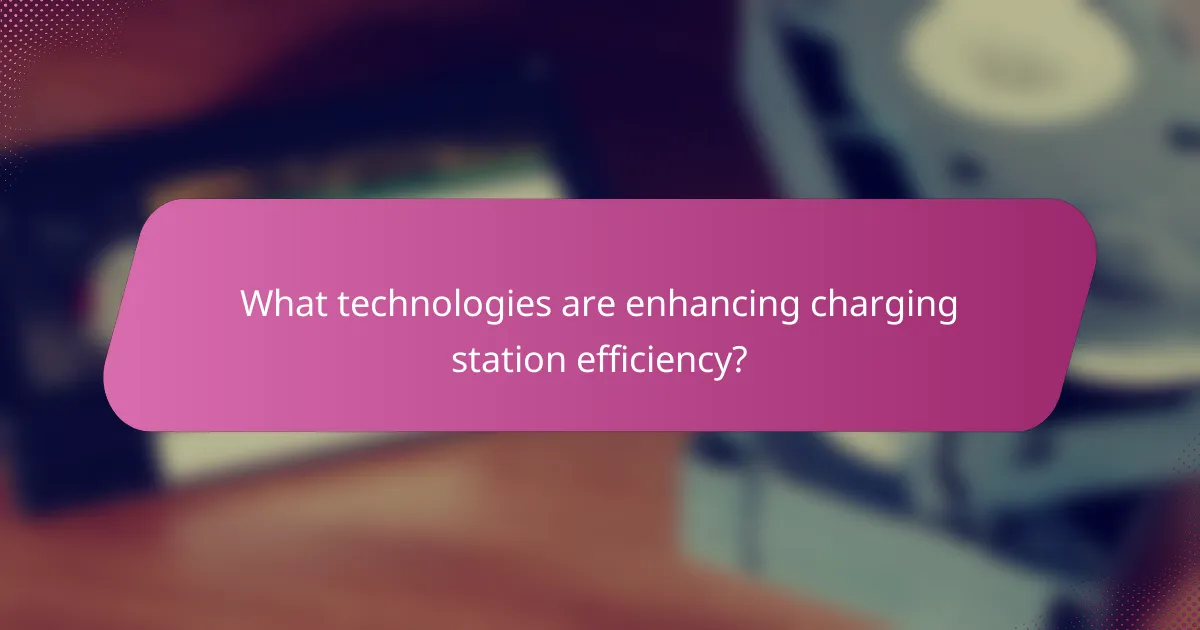
What technologies are enhancing charging station efficiency?
Technologies enhancing charging station efficiency include fast charging solutions, smart grid integration, and mobile payment systems. These advancements improve the speed, accessibility, and user experience of electric vehicle charging.
Fast charging solutions
Fast charging solutions significantly reduce the time required to charge electric vehicles, often providing an 80% charge in around 30 minutes. These systems utilize higher voltage and current levels, allowing for quicker energy transfer compared to standard chargers.
Common fast charging standards include CCS (Combined Charging System) and CHAdeMO, which are widely adopted in many regions. Users should consider the availability of these charging stations on their routes, as not all locations may offer fast charging options.
Smart grid integration
Smart grid integration allows charging stations to communicate with the electrical grid, optimizing energy distribution and reducing costs. This technology can adjust charging rates based on grid demand, ensuring that energy is used efficiently and sustainably.
For instance, during off-peak hours, charging stations can draw power at lower rates, benefiting both the user and the grid. Electric vehicle owners should look for charging stations that utilize smart grid technology to maximize savings and efficiency.
Mobile payment systems
Mobile payment systems streamline the payment process at charging stations, allowing users to pay via apps or contactless methods. This convenience enhances the overall charging experience, eliminating the need for physical payment methods and reducing wait times.
Many charging networks now support mobile payments, enabling users to start and stop charging sessions directly from their smartphones. Users should ensure their preferred charging networks offer these payment options to simplify their charging experience.
